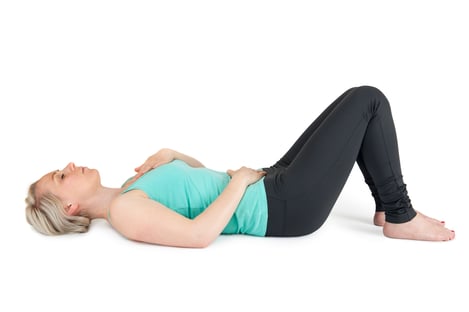 Seriously. Stop and take a breath. Don’t judge your technique, just breathe in and out. Failure to do both in and out will likely result in you fainting, and the ERs and urgent care centers have enough to do without you coming in with a cut forehead requiring stitches.
Seriously. Stop and take a breath. Don’t judge your technique, just breathe in and out. Failure to do both in and out will likely result in you fainting, and the ERs and urgent care centers have enough to do without you coming in with a cut forehead requiring stitches.
Take 5: A Relaxation Exercise
Hold your left hand palm facing up with your fingers slightly spread apart. Place the tip of the index finger of your other hand at the base of the left palm in the slot between the fat pads of the thumb and little finger.
To begin this short exercise, exhale; then as you inhale, let your index finger trace the length of your thumb. When you reach the tip of your thumb, retrace the length of your thumb as you exhale until you return to your starting point. Repeat this exercise for each finger.
If you chose to, you can reverse hand positions and repeat the exercise with your left index finger tracing the fingers of your right hand.
This exercise is short but a powerful way to calm down the fight/flight nerves and bring back physical and mental balance.
Breathwork
There hundreds of breathing techniques to explore and thousands of books written on the subject, going into great detail about what happens when you focus on your breath. I believe it is important and should be explored by anyone who wants to improve their health and wellness. That depth is well beyond the intent of this blog. However, here are some breathing patterns to try.
- Box breathing: Inhale for a 4-count, hold for a 4-count, exhale for a 4-count, hold for a 4-count, repeat. This technique is used by the military to calm soldiers before shooting drills and live action.
- 4 In, 6 Out: No holds, just simple in/out with a slightly longer exhale.
- 4 In, 6 Hold, and 7 Exhale: This is the beginning of longer holds and exhales.
- Focus breathing: Simply watch and follow the breath as it moves in and out. No judgment; just follow. This is the foundation of basic meditation practices.
Finding Balance
We all go through our fair share of stressful situations. It's how you handle them that will help you maintain a healthy outlook . Use these techniques to find your own “life jacket,” a complement to the exercise ideas and nutritional information that NIFS provides. I hope it helps you find your breath, tone down the negative energy, broaden your perspective for your own mental and physical health, and perhaps help others as we go through together.
Your inner peace is your personal power. Therefore,
Peace and Power,
Rick
This blog was written by Rick Huse, NIFS Health Fitness Specialist. To find out more about the NIFS bloggers, click here.


 In The Wizard of Oz, Dorothy woke up after a terrible storm in a world she didn’t recognize. The normal that she had known no longer existed. We are “not in Kansas” (or Indiana, for that matter) anymore after COVID-19 erupted around the world. Normal is gone for the time being. Some people have lost jobs and incomes, or are forced to work from home. Some have had or are fighting the disease, and some unfortunately have lost their lives.
In The Wizard of Oz, Dorothy woke up after a terrible storm in a world she didn’t recognize. The normal that she had known no longer existed. We are “not in Kansas” (or Indiana, for that matter) anymore after COVID-19 erupted around the world. Normal is gone for the time being. Some people have lost jobs and incomes, or are forced to work from home. Some have had or are fighting the disease, and some unfortunately have lost their lives.